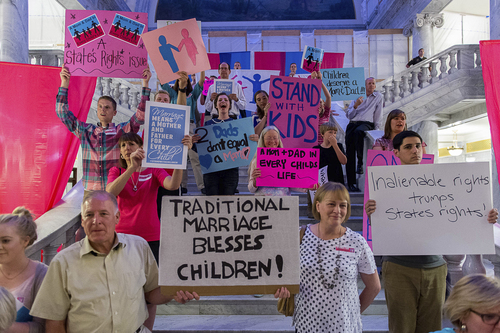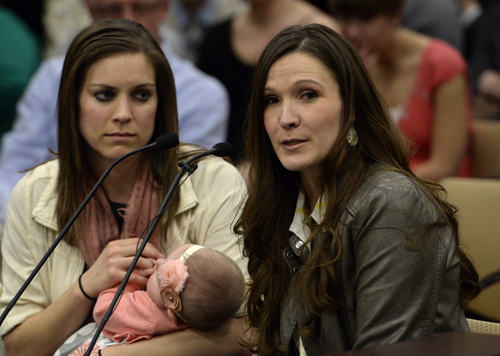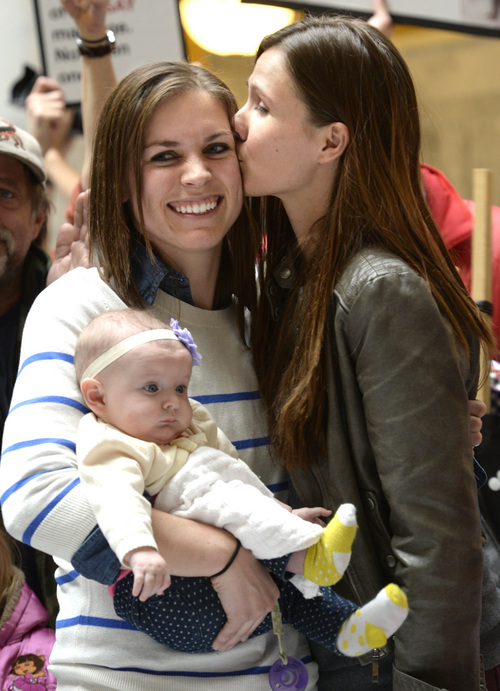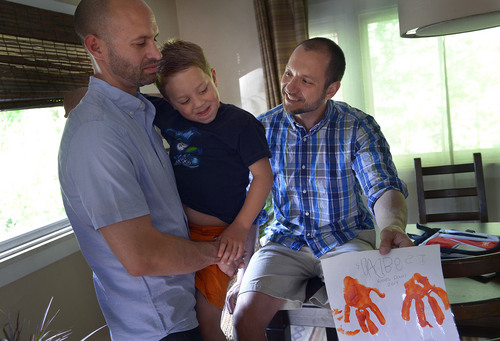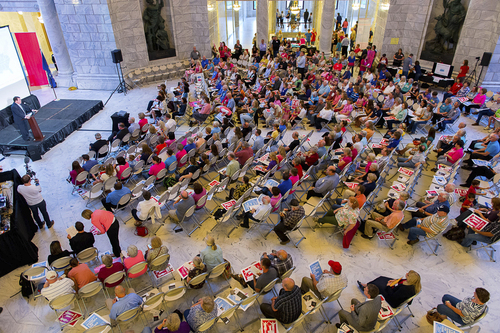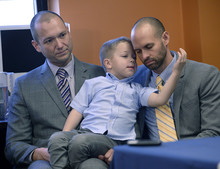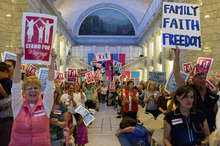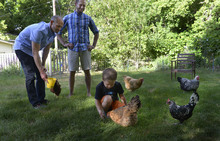This is an archived article that was published on sltrib.com in 2014, and information in the article may be outdated. It is provided only for personal research purposes and may not be reprinted.
In the photo, the baby's eyes are wide as her mother Megan Berrett lifts her above a bouquet of microphones. Her socks are yellow, pants dark blue, a purple flower sits atop her light wisps of hair.
It was a picture Megan Berrett and her wife Candice Green-Berrett said they loved, an image that made them proud of their family, a photo they never thought about twice.
Until last week.
The image, published in The Salt Lake Tribune after a Jan. 10 protest at the Utah State Capitol, became a flash point in the debate over how same-sex marriage impacts children after it was used last week as a rallying cry for limiting marriage to one man and one woman.
The ethics surrounding the use of this photo during last week's rally is murky at best, experts said Monday.
The line between having a right to do something, and it being the right thing to do is often a thin one — hard to define and easily missed, ethics experts said.
"People have certain rights, and because they have those rights they expect they can exercise them," said Michael Pritchard, a philosophy professor at Western Michigan University. "But exercising those rights may be in bad taste or even worse."
For the lesbian and gay families who were shown at last week's Celebration of Marriage rally, which lauded the benefits of opposite-sex relationships and called for the preservation of "traditional" marriage values, there is little room for debate.
"My daughter was up on display for a bunch of people who don't know her and don't know our family so they could judge her and pity her," Candice Green-Berrett told The Tribune. "It made me sick to my stomach."
Mary Summerhays, the founder of Celebration of Marriage and organizer of last week's rally, said it wasn't meant to be an attack when she projected the Berretts' faces on a screen inside the Capitol dome.
She meant it only to respond to the Berretts' own claim that their daughter would suffer if they were denied marriage rights.
The children of same-sex couples, Summerhays said, are poised to suffer "unintended consequences" of being raised by gay and lesbian couples: being denied relationships with their biological mother or father.
"I think what the LGBT community is really seeking is respect. So, to me, I think it's kind of tragic what is happening because instead of this discussion being about respect, it turns into a battle of relationships," Summerhays told The Tribune. "In order for us idealize gay relationships and make marriage universal, it comes at the cost of children's relationships. ... Eventually, they can't really feel good about saying that their own adult relationships are so important that children's relationships to their biological mothers or fathers must end."
Summerhays insisted Monday that her use of the Berretts' likeness was fair game — hadn't they stood up in front of television crews and news cameras to publicly demand that Utah extend legal protection to married same-sex couples and their families?
"They chose to speak at a rally and hold their child up at a podium," she said. "They wanted people to see them."
But not like this, the Berretts said.
It was late Thursday when a friend alerted them to a news story about the rally — and the fact that their family had unwittingly taken center stage.
Megan Berrett was so shaken she couldn't sleep.
All the photos Summerhays used were pulled from local media reports. She credited them to the Tribune and the Deseret News in her remarks.
Legally, she could use the photos. But should she have?
"When you decide you want to be a public figure, that's exactly what can happen to you — once your image is out, sadly, it can be used for alternative purposes," Utah Valley University ethics professor Elaine Englehardt said. "But, usually, we draw the line with children."
Tony Milner and Matthew Barraza, whose 5-year-old son Jesse was also held up by Summerhays as an example of a child whose parents' marriage would deprive him of his biological right to a mother and a father, are plaintiffs in the ongoing lawsuit challenging the state to recognize the marriages of the more than 1,200 gay and lesbian Utahns who wed during a brief window when such unions were legal.
They knew being a party in the lawsuit meant stepping into the spotlight, Milner said. They were ready to defend their relationship, their sexuality, their right to wed.
But, Milner said, they never thought they would have to defend the kind of life they are providing for their child.
"Why would they hold up a picture of our beautiful little family and say this is the enemy? Our heads are still spinning because of it," Milner said. "Sure, say anything you want about us as adults, we can take it. But to say that this is the face of all the children who have been or will be irreparably damaged because of who their parents are? I can't understand it. Why would anyone want to use children in that way?"
Although activists are not held to an ethical standard, Englehardt said, there is one guideline ethicists and philosophers have circled back to since the dawn of time: the golden rule.
"The easiest question that comes up, and everyone from Hobbes to Aristotle to even Jesus Christ has focused on this: Is this something you would want to have done to you?" Englehardt said. "If you show photos of an alternative family and deride them, you should probably ask yourself, 'Would I feel really terrible if they did the exact same thing to me?' There are clearly ways they could have handled it better, such as putting up photos of their families and saying, 'Look how great we are.' "
Twitter: @Marissa_Jae





